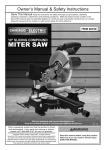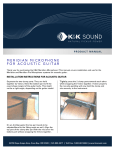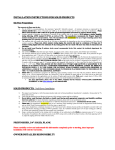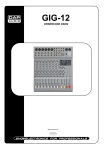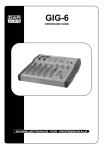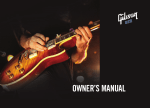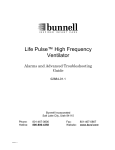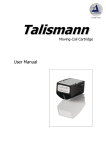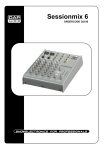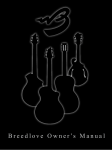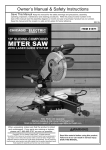Download BEDELL OWNER`S MANUAL
Transcript
BEDELL OWNER’S MANUAL 2014 – 2015 BEDELL GUITARS 61573 American Loop Bend, Oregon 97702 888.234.2210 1 Welcome to the Bedell family! You are now the steward of an extraordinary acoustic guitar, handcrafted from precious tonewoods that were harvested with the intent of sustaining our forests and honoring the surrounding communities and economies. You could’ve chosen any brand, but you chose a Bedell, which means you have a deep respect for the organic materials nature has supplied for your musical instrument. Naturally, you want to protect your investment and to honor the seed-to-song journey of the trees that live again in your guitar. This manual was designed to equip you with the information and tools to provide the highest level of care for your instrument and to ensure that your Bedell guitar will be your musical companion for many years to come. CONTENTS ANATOMY OF YOUR GUITAR 4 CARING FOR YOUR GUITAR 7 HUMIDITY AND TEMPERATURE 8 11 STORAGE AND TRAVEL NITROCELLULOSE FINISH 11 Finish Checking And Aging 13 13 FRETBOARD TUNING MACHINES STRINGS 14 14 ADJUSTING YOUR ACTION ADJUSTING YOUR NECK SETUP SPECS 15 15 17 CHECKING YOUR NECK RELIEF ELECTRONICS 17 18 HOW TO STRING YOUR GUITAR TRAVEL PERMITS WARRANTY 22 22 19 ANATOMY OF YOUR GUITAR 4 ANATOMY OF YOUR GUITAR TOP ROSETTE PICKGUARD BRIDGE BRIDGE SADDLE BRIDGE PIN FRONT OF NECK BLOCK RIM ASSEMBLY BACK CENTER STRIP BACK BRACE KERFING TAIL BLOCK 5 ANATOMY OF YOUR GUITAR HEADSTOCK PEGHEAD OVERLAY NUT FRETBOARD FRETBOARD POSITION DOTS TUNING MACHINES NECK SIDE DOTS HEEL DOVETAIL FRETS ADJUSTABLE TRUSS ROD 6 CARING FOR YOUR GUITAR 7 CARING FOR YOUR GUITAR HUMIDITY AND TEMPER ATURE The trees that live again in your guitar have made an incredible journey to become a part of your world, your music, and your life. Every tree that contributed tonewood to your guitar was selectively and individually harvested, often at the end of its lifecycle (while still standing or from the forest floor, removed gently to minimize the impact on the surrounding ecosystem), or is from a collection of treasured wood harvested prior to 1991 (the year the first tree species was listed in CITES), or was reclaimed and repurposed into wood for your guitar. THE IMPORTANCE OF TEMPERATURE Consider just one of the trees that provided the tonewoods in your guitar – for example the tree that gifted you with your soundboard: When it was living, its Relative humidity (RH) is temperature-dependent. Air with 45% RH at 60° F does not have the same water content as air at 70° F with 45% RH. Stable temperature plays a key role in ensuring your Bedell guitar is humidified properly. leaves were continually pulling water up the trunk and through the pores and fibers of the wood – much like blood moves through the veins in our bodies – and it had a moisture content of up to 200%. When it came to the end of its life and was processed into soundboard sets, moisture still moved through it, but that moisture began to evaporate, and the soundboard began to air dry and cure. At some point, your soundboard reached equilibrium where no more moisture was moving out of the pores. Generally, this equilibrium happens around six to eight percent moisture content, which can usually be maintained in a stable, consistent environment of 70 degrees Fahrenheit with 45% humidity. At equilibrium, even though the wood from the tree is no longer drawing water from the earth, the cells never forget and will draw in extra moisture if it is available, or shed extra moisture if the environment is dry. 8 CARING FOR YOUR GUITAR HUMIDITY AND TEMPER ATURE CONT. Imagine a piece of bread left on the counter in a dry climate. Most bread has 30 – 40% moisture content, and left exposed it will dry up and shrink. Luckily, the wood in your guitar was cured and dried before it was lovingly crafted, but it is still sensitive to fluctuations in temperature and humidity. Much like a cracker or a scone, the wood will respond moisture – both lack and excess – and will expand TEMPERATURE Rule of Thumb: If you’re comfortable, then chances are, the temperature is right for your guitar as well. or contract accordingly – swelling in a warm and humid climate, and shrinking in cold, dry environs. Rapid changes in humidity or temperature can potentially result in cracks, compromised joints and damage to your guitar’s finish. If you’re playing outside and get caught in the rain, when you return indoors, gently wipe down your guitar with a soft, clean cotton cloth and let your guitar dry gradually. Never place a damp guitar near a heat source, like a fireplace. • The ideal temperature for your guitar is around 70° F. • Avoid exposing your guitar to temperatures below 50° F and above 90° F. • Avoid prolonged exposure to temperatures below 60° F and above 80° F. The intense heat and dryness near the fire will cause some parts of the guitar to shrink very quickly, potentially causing cracks and joint damage. One of the best things you can do to protect the beautiful woods and the integrity of your Bedell guitar is to monitor the climate in which it lives. Purchase a small mobile hygrometer gauge to monitor the temperatures and humidity levels to which your guitar is exposed. We recommend an RH of between 40% and 50% and a stable temperature near 70° F to ensure the safest environment for your Bedell guitar. TELLTALE SIGNS OF HUMIDIFICATION ISSUES OVER-HUMIDIFIED UNDER-HUMIDIFIED Raised action Lowered action Sluggish tone, low volume Fret buzzing “Bellying” up of the top Fret ends protruding Lateral finish cracks Dips in the top HUMIDITY •The ideal relative-humidity level for your guitar is between 40% and 50%. •Avoid exposing your guitar to excessively dry or humid climates for more than a few days. •If you live in a dry climate, use a humidifier. •If you live in a humid climate, invest in a de-humidifier. When selecting an in-case humidifier, avoid designs that completely block the sound hole – they can cause overhumidification of the instrument body, while doing little to maintain proper humidity for the neck. 9 CARING FOR YOUR GUITAR HUMIDITY AND TEMPER ATURE CONT. If you and your guitar spend more tially damaging. We recommend a period of time, even the glue under than a few days in an arid climate storing your guitar in the case when the bridge can be compromised, (below 40% RH), protect and stabilize not in use, and investing in a humid- potentially causing the bridge to pull your instrument with a high-quality ifier that vaporizes the moisture, to off. If you and your guitar live, or variable-control room humidifier or lessen the chance that any water spend an extended amount of time, an in-case guitar humidifier, such as droplets might come in contact with in a highly humid climate (RH levels the Oasis sound-hole humidifier. If your instrument. above 50%), we suggest purchasing a choosing an in-case humidifier, select variable-control dehumidifier to achieve one containing a moisture reservoir Additionally, if you visit a sweltering optimal RH. that is suspended inside the body to tropical climate make sure your guitar release proper levels of moisture that stays cool and isn’t trapped in the hot, A final word about humidity and temp- also prevents water from actually moist case. When humidity is high, wood erature levels: Avoid hanging your touching your instrument. Be careful expands and swells. When humidity guitar on an outside wall. The temp- when placing your guitar near a is combined with high temperatures, erature difference between the interior standard room humidifier, as water your guitar’s glue joints can weaken of the room and the wall itself can may come into direct contact with and even open slightly. If you leave potentially damage your guitar’s wood. your instrument, which is a poten- your guitar in a hot, humid spot over 10 CARING FOR YOUR GUITAR STORAGE AND TRAVEL When you’re not playing your Bedell, return it to its case. The case gently and evenly supports the body, neck, and head of your guitar, which helps keep everything in proper alignment. Your instrument will be happy; you’ll be happy. When it comes to car travel, treat your guitar like you’d treat a beloved pet. Never leave your Bedell in a blazing hot car, or in an unheated car during winter months. Would you transport the family dog in the trunk? Hopefully not. Never ever leave your guitar in the trunk of your car where it can be exposed to extreme temperatures; the trunk of your car is no place for your stunning and lovingly crafted Bedell guitar. If you’re flying, check your guitar at the gate if possible, so the baggage compartment large enough for your packing material in your case around handler can hand-carry your guitar guitar case. your guitar to protect it as much as to and from the airplane, and you’ll possible during its journey. When be able to keep an eye on it until you If you absolutely must check your you arrive at your destination, leave board. If this isn’t an option, call the air- guitar, loosen the strings slightly (about your guitar in the case until it has line to see if the cabin has a storage a step and a half ) and place soft cotton acclimated to the new temperature. NITROCELLULOSE LAQUER FINISH Your Bedell guitar has a hand-applied moisture or perspiration. Additionally, create by simply playing your guitar. nitrocellulose that one of the well-known features of a Any imperfections caused over time maximizes the resonant qualities of lacquer finish nitrocellulose finish (often referred to add to the value of the instrument and your tonewoods. This thin, hard finish simply as “nitro” or “lacquer”) is that it contribute to the unique character of is more susceptible to the elements develops a patina over time – a patina your instrument – making this guitar than other finishes. For instance, it that is as uniquely you as your music… your guitar. requires special care when exposed to a one-of-a-kind visual identity you 11 CARING FOR YOUR GUITAR NITROCELLULOSE LAQUER FINISH CONT. The best way to care for your finish – aside from avoiding drastic changes in temperature and/or humidity – is to lightly clean your guitar after each use. Your sweat may oxidize fairly quickly and can dull or destroy the finish. The same goes for the natural oils in your skin. When cleaning, you want to remove dirt, oils and sweat – but you don’t want to remove the patina that develops over time. Use a soft, 100% cotton cloth to wipe down the entire instrument. Wipe the strings, too, to remove the oil left behind by your fingers; it will help the strings last longer. NITROCELLULOSE CARE 101 We don’t recommend commercial polishes or cleaners because they may •Do not expose your guitar may even contain abrasives, which will harm the finish and strip the hard- to extreme climate changes. •Wipe down your guitar with a clean, soft, 100% cotton flannel cloth after every session. • Avoid commercial guitar cleaners, polishes and oils. •Don’t touch up any scratches or dings (this should be done only by experienced repair specialist). contain petroleum products or solvents that will deteriorate your finish. Some earned patina from your guitar. Your finish should not require waxing or oiling either (with the exception of the fretboard; see below). Traditional oils, like tung oil, may leave a residue even when wiped clean and can seal in any grime or dirt on the surface – this residue will also build up when used repeatedly. While we do not recommend waxing, if you must wax your guitar, pure carnauba wax is the safest for your finish. Scratches, dings and checking that develop over time are all a part of your guitar’s unique fingerprint. If you feel compelled to repair the finish, take it •If you use a guitar to a repair specialist who specializes in nitro finish repair. Do not attempt to •Only use stands and Remember to remove your guitar strap when not in use. Some strap materials, strap, remove after use, and store separately. wall hangers that are specifically “nitrocellulose safe,” or place a clean, soft, 100% cotton cloth between your instrument and all contact points. touch it up yourself. even leather, and particularly synthetics, contain solvents that can mar the finish of your guitar. Feel free to use the strap of your choice while you play, just be sure to remove it when you’re done. And don’t toss the strap into the case with your guitar; store it separately. The safest place for your guitar is in the case, but if you temporarily leave your guitar on a stand or wall hanger, make sure that these accessories are specifically designated as “nitro safe.” If your accessories are not approved for contact with nitrocellulose finishes, then cover all contact points with soft, 100% cotton cloth. 12 FINISH CHECKING AND AGING As a normal part of the aging process, most nitro finishes will exhibit checking and may change color or develop the sheen or patina discussed earlier. Guitar aficionados often believe these natural aesthetic changes add to the value of the instrument, as they tell the story of the instrument and the player and their journey together over the years. Finish checking – a common, expected occurrence in fine instruments with a nitro finish – is a web or mosaic pattern of hairline cracks in the finish usually caused by sudden changes in temperature. As the wood rapidly expands or contracts, it stresses the finish and creates checking. This is common as an instrument ages, and some musicians actually seek out a checked finish in vintage instruments since it adds to the historical authenticity and well-loved, well-played feel. Finish checking can occur after your guitar has been in very cold conditions, when it is suddenly introduced to a warm venue or room; the wood expands faster than the lacquer, and this may distress the finish. The best way to guard against checking is to avoid exposing your Bedell to extreme temperatures. If you cannot avoid exposing your guitar to an arctic chill or sweltering heat, allow the instrument to slowly acclimate to new climate conditions before you open the case. As always, avoid any prolonged exposure to temperatures below 60° F and above 80° F. CARING FOR YOUR GUITAR FRETBOARD When cleaning your instrument after play, pay special attention to your fretboard If your fretboard appears dry or cracked, before oiling take a humidity to remove the oil residue left by your fingertips. When oil and dirt build up on your fretboard, it will become a bit “gummy,” and may require occasional cleaning and oiling. TO REMOVE FRETBOARD RESIDUE: measurement to ensure proper humidification levels (between 40% - 50% relative STEP ONE Rub your fretboard lightly with ultra-fine (0000) steel wool. STEP TWO Remove any steel wool fragments. STEP THREE Apply mineral oil to the fretboard. STEP FOUR Wipe down the fretboard with a dry cotton cloth. humidity). If you find the environment is too dry, establish proper humidity as needed, and then follow the steps to the right. 13 CARING FOR YOUR GUITAR TUNING MACHINES The tuning machines on your guitar your open tuning gears. To do this, catch dust that will wear out the tun- will need little, if any, maintenance dab a tiny bit of petroleum jelly on the ing machines. beyond occasional lubrication. Mark end of a toothpick and apply to the your calendar twice a year to lubricate gears. Don’t apply too much or it will STRINGS The luthiers at Bedell selected the perfect strings to compliment the body STRING SPECS Dreadnoughts and Jumbos: Medium (.013-.056) shape of your guitar. Should you desire different strings to accommodate your individual playing style, your steel-string acoustic guitar is designed for use with light- and medium-gauge strings. If you switch to lighter-gauge strings, you’ll likely need to have a reputable dealer adjust the bridge saddle and neck to avoid fret buzz. 1 e .013 2 B .017 Your guitar strings will wear out. How quickly depends on how often and 3 G .026 4 D .035 5 A .045 become a bit muffled. When this happens, replace the entire set of strings. Only 6 E .056 replacing one will result in an unbalanced sound. how long you play – and whether you wipe the strings with a cloth after each session. The oils from your fingers corrode the strings over time. How will you know when it’s time? You’ll notice your sound has lost its brilliance and has Parlors and Orchestras: Light (.012 - .053) 1 e .012 2 B .016 3 G .024 4 D .032 5 A .042 6 E .053 For step-by-step directions on how to string your guitar, see page 17. 14 CARING FOR YOUR GUITAR ADJUSTING YOUR ACTION Because the solid woods in your guitar Likewise, if the strings are too low, height and trussrod tension, since will settle and change over time as they’ll buzz against the frets. If either one or both may be responsible. your guitar matures, the height of scenario should occur, and your IF YOU ARE INEXPERIENCED, the strings will increase or decrease action requires adjustment, take your DO NOT ATTEMPT TO ADJUST slightly. If the action is higher, your guitar to a repu-table guitar repair THE ACTION YOURSELF. guitar will be a bit harder to play. specialist to assess bridge-saddle ADJUSTING YOUR NECK TRUSS ROD ADJUSTMENTS AND ACTION Adjustments to truss-rod tension alter the relative straightness of the neck. While these adjustments may impact your action (or string-height), the height of the saddle is also a factor. If you suspect your neck angle may be impacting your string height, the wisest course of action is to take it to your guitar dealer or reputable repair specialist. The trussrod in your Bedell guitar helps counteract the affect of string tension on the neck of your instrument. String tension pulls the neck forward and up, while the truss rod pulls the neck down and back. A properly adjusted truss rod equalizes the tension on the neck. Adjustment of truss rod tension changes the amount of bow in the plane of the fretboard. A properly adjusted truss rod results in a neck with a slight forward relief. If you look down the neck of your guitar and perceive a slight bow, don’t assume that it that it needs to be straightened. Depending on your playing style, a slight bow can work in your favor by preventing fret buzz. Also, the neck may move slightly with changes in humidity and temperature, but may not need adjustment. 15 CARING FOR YOUR GUITAR ADJUSTING YOUR NECK CONT. Prior to adjusting tension on your new Bedell guitar, give your instrument a couple TRUSS ROD BASICS •Turn your wrench clockwise of weeks to adjust to its new environment. USE EXTREME CAUTION WHEN MAKING ADJUSTMENTS. to tighten the truss rod, counterclockwise to loosen it. To adjust the single-action truss rod on your Bedell guitar, use a round-tipped •The truss rod should only be the sound hole, toward the neck. It is very close to the top of the guitar, and directly adjusted in order to establish proper neck relief and to counteract/balance the effect of string tension. •Do not use the truss rod 5/32” Allen wrench that is at least 4” long. The adjustment nut is located inside underneath the fretboard. To access the adjustment nut, insert the wrench into the sound hole between the D and G strings (holding them apart can be helpful) and point it up toward the area described above to find the nut. Turn clockwise to tighten the truss rod, or counterclockwise to loosen it. adjustment feature to try to correct larger set-up issues or other problems that are not related to neck relief. • If you are inexperienced with this type of adjustment, consult a qualified repair technician before attempting an adjustment. 16 CARING FOR YOUR GUITAR SET-UP SPECIFICATIONS To check your guitar for proper action, measure at the 14th fret, from the top of the fret to the bottom of the string. Bedell specs are 3/32” on the bass side and 1/16” on the treble side. You may want to have your guitar adjusted for higher or lower action, depending on your playing style. CHECKING YOUR NECK RELIEF To check for proper neck relief, push down on the low E string at the 1st and 14th frets simultaneously. There should be about 0.010” of space between the bottom of the string and the top of the 6th fret – about the thickness of a business card. You may want more or less relief depending on your playing style. 17 CARING FOR YOUR GUITAR ELECTRONICS All workshop-installed electronics packages are handcrafted and assembled NOTE If your model is not listed, please refer visit bedellguitars.com to review determine the electronics installed in your specific instrument, then download the appropriate manual at kksound.com/support/ manuals.php. in Coos Bay, Oregon by K&K Sound. For more information on your electronics package, please download the relevant owner’s manual below. REVERE: POWER MIX PURE XT kksound.com/pdf/powermixpurext.pdf COFFEE HOUSE: PURE MINI kksound.com/pdf/puremini.pdf 1964: PURE MINI kksound.com/pdf/puremini.pdf EARTHSONG: DUOTONE kksound.com/products/duotone.php 18 HOW TO STRING YOUR GUITAR 19 HOW TO STRING YOUR GUITAR STEP ONE STEP TWO Insert the first string in its bridge-pin hole. Make sure Position the bridge pin so the notch is the heaviest part of the double winding is facing away facing the string. from the sound hole. Pull the ball end of the string tightly against the inside of the top. STEP THREE STEP FOUR Insert the bridge pin by pushing it firmly Thread the string through the string hole near with your thumb. the top of the tuning machine post. 20 HOW TO STRING YOUR GUITAR STEP FIVE STEP SIX Wind the string half way around the tuning machine post. Pass the short end of the string under the longer end and NOTE: For the three treble strings, wind the then bend back the short end to prevent the string from string counterclockwise. For the three bass strings, slipping. Repeat steps 1 through 6 for all remaining strings. wind the string clockwise. NOTE: For instruments equipped with an undersaddle pickup (all instruments with K&K PowerMix Pure XT), we recommend that you restring your instrument starting with the two middle strings, and work your way outward to ensure that the saddle will reseat firmly and squarely over the pickup. STEP SEVEN Tune your guitar. Then make sure each string winds around the tuning machine post at least one full rotation, with each winding closer to the base of the shaft than previous windings. Clip the strings flush with the top of the tuning machine post if desired. 21 TRAVEL PERMITS & WARRANTY 22 TRAVEL PERMITS & WARRANTY TRAVEL PERMITS All Bedell tonewood is ethically wood from restricted species qual- for your Bedell guitar, please and legally procured, meeting all ifies for the U.S. Fish and Wildlife email [email protected], CITES regulations and Lacey Act Service Guitar Passport and can or call our concierge service at require-ments for chain of custody. be transported for performances 888.234.2210 between 8:00 a.m. We guarantee that every USA throughout the world. For assis- and 5:00 p.m. Pacific Time. made Bedell guitar crafted out of tnce procuring a travel permit WARRANTY AS THE ORIGINAL OWNER OF YOUR BEDELL GUITAR, YOU ARE ENTITLED TO A LIMITED LIFETIME WARRANTY. For more details, please visit: bedellguitars.com/warranty 23 BEDELL GUITARS 61573 American Loop Bend, Oregon 97702 888.234.2210 [email protected] 24
























